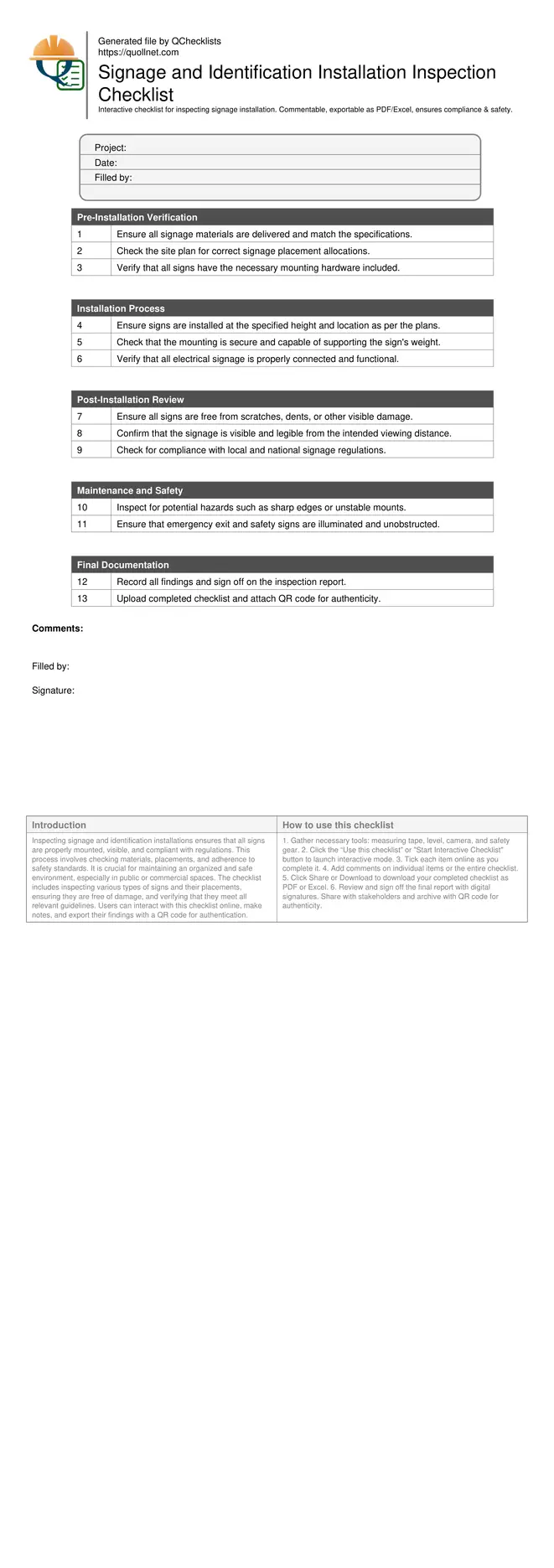Signage Installation Inspection
Inspecting signage and identification installations ensures that all signs are properly mounted, visible, and compliant with regulations. This process involves checking materials, placements, and adherence to safety standards. It is crucial for maintaining an organized and safe environment, especially in public or commercial spaces. The checklist includes inspecting various types of signs and their placements, ensuring they are free of damage, and verifying that they meet all relevant guidelines. Users can interact with this checklist online, make notes, and export their findings with a QR code for authentication.
- Ensure that all signage installations are visible and compliant with safety standards.
- Verify that identification signs are correctly placed and free from damage.
- Interactive online checklist with tick, comment, and export features secured by QR code.
- Comprehensive inspection ensures organizational and safety compliance in public spaces.
Pre-Installation Verification
Installation Process
Post-Installation Review
Maintenance and Safety
Final Documentation
Importance of Proper Signage Installation
Proper signage installation is critical for safety, navigation, and compliance. Signs ensure that individuals can easily find their way, recognize hazards, and identify important locations. Proper installation minimizes risks associated with poor visibility or incorrect information. It also enhances the aesthetic appeal and functionality of spaces.
- Facilitates navigation and orientation for users.
- Ensures compliance with regulatory standards.
- Prevents accidents and enhances safety.
- Contributes to the professional appearance of the facility.
Common Mistakes to Avoid
Avoiding common mistakes during signage installation can save time and resources. Incorrect placements, improper mounting, and overlooking regulatory requirements can lead to costly corrections and potential safety hazards. Ensuring thorough checks at each stage of installation is vital for success.
- Incorrect sign placement leading to poor visibility.
- Improper mounting that can cause instability.
- Neglecting to check compliance with local codes.
- Failing to inspect for physical damage post-installation.
How to Use the Signage Inspection Checklist
- Gather necessary tools: measuring tape, level, camera, and safety gear.
- Click the “Use this checklist” or "Start Interactive Checklist" button to launch interactive mode.
- Tick each item online as you complete it.
- Add comments on individual items or the entire checklist.
- Click Share or Download to download your completed checklist as PDF or Excel.
- Review and sign off the final report with digital signatures. Share with stakeholders and archive with QR code for authenticity.
Call to Action
- Start Checklist Tick off tasks, leave comments on items or the whole form, and export your completed report to PDF or Excel—with a built-in QR code for authenticity.
- Download Excel - Signage and Identification Installation Inspection
- Download PDF - Signage and Identification Installation Inspection
- View Image - Signage and Identification Installation Inspection

